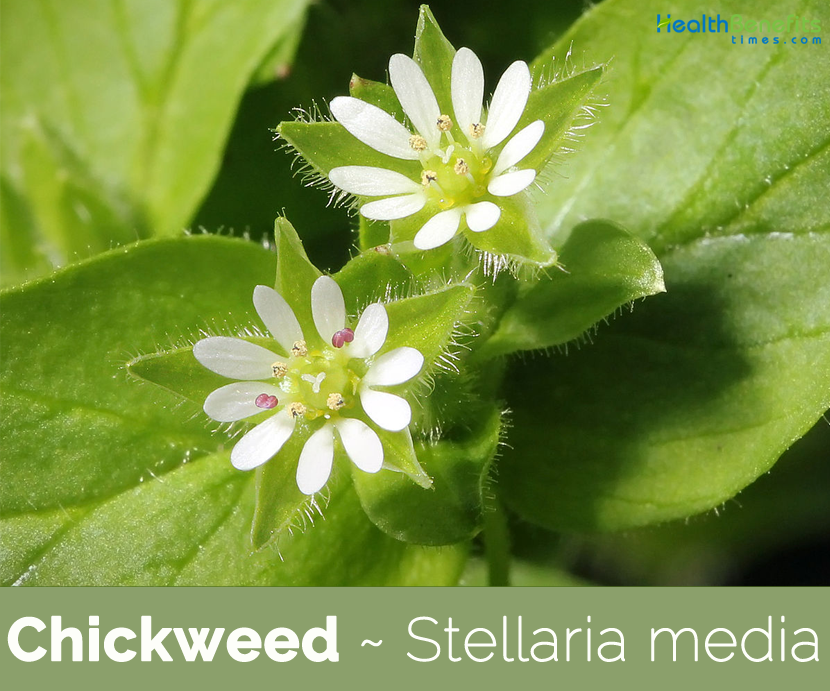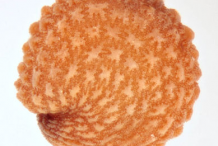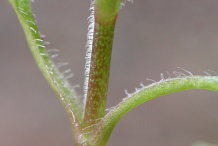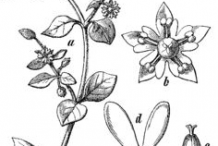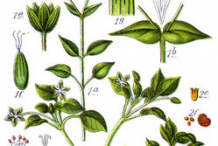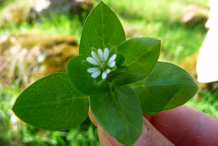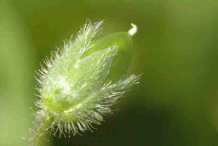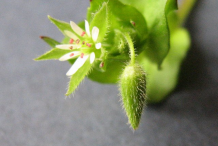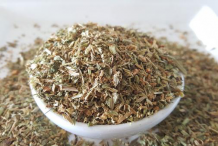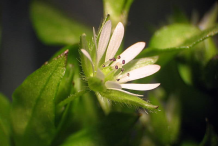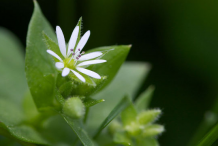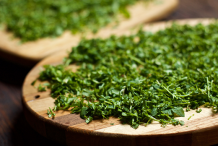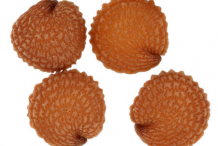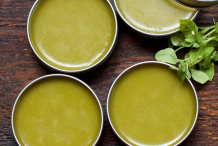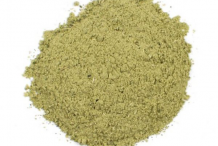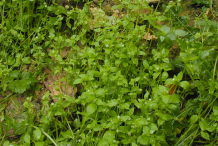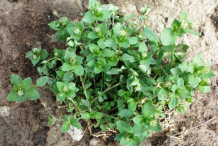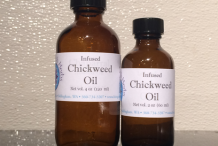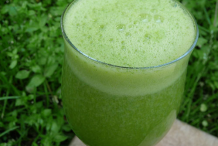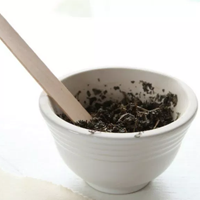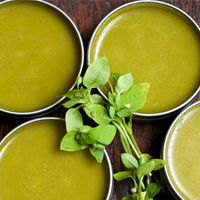The plant is commonly called the “snow in the summer” because of its small white star-shaped flowers that usually bloom in the spring and last until autumn. The genus name Stellaria refers to chickweed’s tiny, white, star-shaped flowers. The common name refers to the herb’s appeal to birds and barnyard fowl, particularly young chickens. Most people considered it as a troublesome weed. The fact is that is plant is actually a useful herb we can take advantage of. The leaves and flowers open up fully when good weather is approaching. Likewise the leaves and flowers fold up shut when rain is on its way. Over time, it also became naturalized in North America and can be found in recipes and cultural specialties around the world. For those who worry about the safety of chickweed, it is completely safe to consume in moderation. While it is not the most popular leafy addition to a salad, this plant has a pleasant taste and has a slightly different growing season.
Plant Illustration
Chickweed is a prolific, low growing, annual, winter annual or sometimes perennial herb that grows about 15 cm (6 in) tall, sometimes up to 40 cm (15 in). The plant is found growing in woodland areas prone to flooding, thickets, cropland and fallow fields, lawns and gardens, nursery plots, cultivated fields, pastures, gardens, shady lawns, roadsides, wasteland, areas adjacent to buildings, and miscellaneous waste areas. The plant grows on a very wide range of substrates, but prefers moist, fertile soils with a neutral pH and good aeration. The plant has fibrous, shallow root system.
Stem
Stem is much branched, erect or ascending from a creeping base, rather weak, minutely pubescent in longitudinal lines bearing a single row of hairs on alternating sides of successive nodes, 20 to 80 cm long trailing on the ground, juicy, pale green and slightly swollen at the joints.
Leaves
Leaves are opposite, simple, succulent, egg-shaped very variable in size in different plants, smooth, or fringed with hairs near the base, ovate-elliptic, acute or shortly acuminate, 6 to 30 mm long, 3 to 15 mm wide; petiole of lower leaves 5 to 20 mm long and having a line of hairs, petioles of the highest leaf often very short or sessile.
Flower & Fruit
Chickweed flowers are small, white, and are held tightly in the upper leaf axils. They open into loose branching clusters with age on ½ inch hairy stalks. Each flower is about 1 cm across with 5 deeply notched white petals, usually with ten stamens with light yellow to greenish or even reddish anthers and a round green ovary in the center with 5 filament-like styles at the top. The five sepals are about as long as the petals, lanced shaped with fine, spreading hairs on the outer surface. Flower stalks are also slightly hairy; at flowering time they are erect to ascending and longer than the sepals, spreading more when fruiting.
They open about nine o’clock in the morning and are said to remain open just twelve hours in bright weather, but rain prevents them expanding, and after a heavy shower they become pendent instead of having their faces turned up towards the sun, though in the course of a few days rise again. Flowers are followed by many seeded dry capsule, ovoid, usually a little longer than the sepals, opening by six teeth, breaking into five segments at maturity. Seeds are dark brown, yellowish or dull reddish-brown, nearly circular, slightly elongated toward the notch at the scar, about 1 mm across, the surface covered with conspicuous curved rows of irregular wart-like projections, marginal projections are more prominent and toothed in appearance.
Health benefits of Chickweed
Chickweed is often used for digestive problems, and it can help with constipation and stomach issues. Since it has laxative properties, chickweed tea is sometimes recommended for weight loss, but any weight loss would be temporary, so it’s not really practical. Topically, it’s used for skin conditions and it can be made into creams and ointments for psoriasis, itching and dry skin. Listed below are few of the health benefits of Chickweed
Prevents Inflammation
Chickweed when consumed or applied externally has powerful anti-inflammatory compounds that help it ease discomfort and pain. This is mostly beneficial for people who are suffering from chronic inflammatory conditions, such as osteoarthritis or irritable bowel syndrome (IBS), among others.(1)
2. Aids Digestion
Fiber, minerals, and antioxidants found in this plant helps to improve digestion, while also balancing the bacterial environment in your gut and supporting the immune system, more than 50% of which operates within the gastrointestinal system.(2)
3. Skin Care
There are numerous topical applications of this herb that can recover the appearance and health of your skin. The herb is loaded with minerals and antioxidants and can prevent oxidative stress and calm inflammation from things like eczema, acne, rosacea, psoriasis. It can even improve the appearance of scars and wrinkles! (3)
4. Weight Loss
Many people drink chickweed tea because it consists of good amount of diuretic and laxative qualities, which can help people, lose water weight. On top of that, however, some research has found that this herb also suppresses the appetite, further helping to limit calories and aid weight loss efforts.(4)
5. Treats Respiratory Problems
Some of the antioxidants in chickweed, namely the saponins, can act as expectorants in the respiratory system, helping you expel phlegm and mucus. This will relieve inflammation in those tracts, helping you breathe normally, while also removing many of the fundamental infections of that system.(5)
6. Speeds up Healing
Applying poultices or compresses of this herb to wounds encourages circulation and blood flow while protecting against infections, which speeds the healing process.
7. Constipation
Chickweed is traditionally consumed to soothe the consumption in the human body. Constipation is mainly due to the insufficient bowel movement. The goodness is due to the ample amount of the fiber innate.
8. Vision
The goodness of the beta-carotene innate in the chickweed is helpful in obtaining the normal vision. Beta-carotene is the source of the vitamin A, which is vital to obtain the healthy vision.
9. Nasal Congestion
The presence of the saponin in the chickweed is beneficial in the removal of the mucus from the respiratory tract. This produces good effects on the human body.
10. Joint Pain
Joint pain is due to the inflammation of the skin and the use of the chickweed with the anti-inflammatory property is helpful in the soothing of the wound.
11. Fever
When used as a febrifuge, chickweed can help to bring down a fever. It is really important to know the cause of a fever before attempted to bring down the body temperature. Fever is a natural response to infection or illness. Many illnesses increase at normal body temperature, and a fever is a good indication that the immune system is functioning to ward off the infection. In fact, a fever is a good sign as it means that the body is responding to fight the infection. A fever can become dangerous when it reaches 105°F. Speak with a trained health professional as to when you should seek medical help when fever strikes.
Traditional uses and benefits of Chickweed
- Chickweed has a very long history of herbal use, being particularly beneficial in the external treatment of any kind of itching skin condition.
- It has been known to soothe severe itchiness even where all other remedies have failed.
- Whole plant is astringent, carminative, demulcent, diuretic, expectorant, laxative, and refrigerant, vulnerary.
- Taken internally it is useful in the treatment of chest complaints and in small quantities it also aids digestion.
- An infusion of the fresh or dried herb can be added to the bath water and its emollient property will help to reduce inflammation – in rheumatic joints for example – and encourage tissue repair.
- Decoction of the whole plant is taken internally as a post-partum depurative, emenagogue, galactogogue and circulatory tonic.
- It is also supposed to relieve constipation and be beneficial in the treatment of kidney complaints.
- Decoction is also used externally to treat rheumatic pains, wounds and ulcers.
- Expressed juice of the plant has been used as eyewash.
- Fresh leaves have been used as a poultice for inflammation and indolent ulcers with most beneficial results.
- Poultice of Chickweed enclosed in muslin is a sure remedy for a carbuncle or an external abscess.
- Water in which the Chickweed is boiled should also be used to bathe the affected part.
- Decoction made with the fresh plant is good for constipation.
- An infusion of the dried herb is effective in coughs and hoarseness.
- It has been used as a remedy to treat itchy skin conditions and pulmonary diseases.
- 17th century herbalist John Gerard recommended it as a remedy for mange.
- Modern herbalists mainly recommend it for skin diseases, and also for bronchitis, rheumatic pains, arthritis and period pain.
- Poultice of chickweed can be applied to cuts, burns and bruises.
- Chickweed is used as herbal treatment for Skin problems like Roseola, Eczema, and Psoriasis.
- It reduces itching and irritation.
- It is beneficial if you have dried or chapped Skin and Bug Bites.
- It is useful in healing Acne and red pimples.
- External use of Chickweed is very effective for the treatment of Sores, Boils, and Burns.
- Chickweed soothes swelling on the Skin.
- Anti-inflammatory properties of Chickweed reduce Internal and External inflammation.
- It helps in treating Scurvy (Bleeding Gums).
- It is a natural pain killer and is helpful in treating Muscle and Joint pains.
- Consumption of Chickweed eases the Stomach and Intestinal problems.
- Tea made of Chickweed helps clean the Intestines and the Kidneys by removing toxic waste from the body.
- It is also used for treating the Urinary Tract Infections and Cystitis.
- It helps in restraining Respiratory problems and reduces Phlegm in the lungs.
- It acts as a tonic for Lung congestion, Flu, Bronchitis and treats Asthma.
- It is helpful in treating obesity and lowers down the Cholesterol level in the body.
- Decoction has been used in traditional herbal medicine to treat cystitis and other related urinary tract inflammations.
- Decoction of the fresh aerial parts is a traditional treatment for relief from extreme physical fatigue and debilitation.
- Use the ointment applied on a bandage to help draw splinters.
Ayurvedic Health benefits of Chickweed
- Urinary Tract Infections: Have 20-30 drops of Chickweed tincture daily for 3 months.
- Erysipelas: Prepare a poultice of the leaves of Chickweed. Apply on the affected area.
- Urticaria: Take chickweed in a powder form. Prepare a paste. Apply it over the affected area.
- Obesity: Drink Chickweed ( Buch Bucha ) tea regularly. It is an old remedy to cure Obesity.
- Blurred Eyes: Take the leaves and the Flowers of Chickweed, Barberry, Marigold, Goldenseal, Oregon Grape, Eyebright, Cornflowers. Prepare an infusion. Let it cool. Use as an eyewash, 2-3 times a day.
- Liver Diseases: Prepare a powdered mixture of equal amount of Red clover, Fennel, Cleavers, Dandelion, Oregon grape root, Burdock root, Chickweed and Parsley root. Boil 1 to 2 cups of water. Add one teaspoon of the powered mixture in it. Allow it to get cool down. Consume 1 cup of tea once a day before breakfast.
Other Chickweed Uses
Chickweed can be used in many ways, both in culinary and medicinal applications, such as in the form of an oil, compress, tea, poultice or salad vegetable.
- Infused Oil: If you infuse oil with chickweed leaves and allows them to soak overnight, you can then use this oil for topical applications on the body, or you can add it to your bath, which can relieve skin conditions and inflammation.
- Tea: Many people choose to brew a delicious, earthy tea from this herb’s leaves, mostly because this appears to have notable weight loss properties, thanks to the laxative and diuretic abilities of this herb.
- Compress: If you make a decoction of chickweed leaves, you can soak a compress in the mixture and apply it directly to wounds, inflamed areas, or parts of the skin that require treatment.
- Poultice: You can crush the leaves of the chickweed plant into a light paste and topically apply it to acute injuries and wounds to speed the healing process.
- Salad Vegetable: Perhaps the most popular use of this plant, you can add a handful of these leaves, flowers and the top part of the plant to your salad for a unique flavorful bite and a number of excellent internal health benefits. The stems, however, are less palatable to eat as a raw vegetable.
- Smoothies and Raw soups: Chickweed is a perfect addition to green smoothies or can be mixed up with any fruit to create a refreshing frothy drink. As a saponins-rich wild edible, when blended it froths up similar to the consistency of eggs in the traditional American drink called the “Orange Julius.” It can be used with other citrus fruits or pineapple to create the same effect. A small handful is perfect for any raw soup recipe, blended up with spices, miso and avocado for wild soup meal.
- Juice: Chickweed is also an excellent ingredient in juicing recipes when juicing other greens, fruits and vegetables. It is a great herb to use when juice fasting to help clean the lymph and detox the body. The fresh pressed juice is maybe the most beneficial way to consume this wild edible.
- Lightly steamed: Chickweed can be chopped and steamed with a taste similar to spinach. It can be used in much the same way you would use any leafy green, but it loses a good portion of its nutritional value when cooked over several minutes.
- Chickweed extracts: Tinctured extracts of the plant are also available or you can make your own using an alcohol menstruum.
Culinary uses
- Young leaves raw or cooked are used as a potherb.
- They can be added to salads whilst the cooked leaves can scarcely be distinguished from spring spinach.
- Seeds are ground into a powder and used in making bread or to thicken soups.
- Leaves may also be used uncooked with young Dandelion leaves to form a salad.
Dosage and Administration
Taken as an internal remedy, the recommended dosage is about 1-5 ml daily of the herbal tincture
Taken as a tea, pour one cup of boiling water over two teaspoonful of the dried herb and steep for 5 minutes; do not allow the herb to boil.
Chickweed Tea Recipe
Ingredients
- 2 or 3 tablespoons fresh chickweed herb/ 2 teaspoons dried chickweed herb, chopped/crumbled
- 8 oz or 1 cup water
Method for Dried Chickweed
- Boil the water in a saucepan.
- Remove water from heat and pour into a cup.
- Add chickweed to the cup.
- Let it steep for 5 minutes.
- Strain chickweed out and drink tea while hot.
Method for Fresh Chickweed
- Boil the water in a pan.
- In a cup, place the fresh chickweed.
- Pour boiling water over the herb.
- Let the mixture infuse for 15-20 minutes.
- Strain the mixture and drink the tea hot.
Poultice with Fresh Herbs
- Take the herbs you have chosen and chop them into small pieces on a cutting board.
- Transfer the herbs to a mortar and pestle, and crush the chopped herbs until they become a pulp.
- The end result needn’t be silky smooth – the main thing is to start the juices flowing.
- As you chop and mash, the herbs will release their natural juices and the leaves will become softer.
- Herbs may also be chopped using a blender instead of a cutting board and mortar and pestle.
- Spread the crushed herbs onto the desired area of the skin.
Poultice with Dried Herbs
- Take desired dried herbs and combine with just enough hot water to moisten them.
- For roots, it’s best to use a powdered form.
- Simply add hot or cold water a little at a time to create a thick paste.
- Spread the paste evenly over the desired area.
- Wrap with gauze or muslin.
Infused Chickweed Oil
Ingredients
- 2 handfuls of fresh chickweed leaves
- 1 1/4 cups coconut oil
Procedure
- Finely chop the fresh chickweed and arrange on a cutting board or cookie sheet. Allow the chopped chickweed to wilt for 12 to 24 hours.
- Measure out 1 1/4 cups of coconut oil. Add the wilted chickweed to the oil. To acquire the best quality of oil, there should be an equal amount of chickweed and oil in the mixture.
- Use a blender to mix the chickweed and the coconut oil together. It typically takes 15 to 20 seconds before the two ingredients are fully blended together. You can also use a food processor for this step.
- Place the mixture on top of a double boiler or improvise by placing a bowl on top of a pan that has about 2 inches of water in it. Bring the water to a boil and then reduce to a simmer. Stir the oil occasionally until the oil is warm to the touch.
- Allow the mixture to sit for a few hours. Repeat step 4 for about four times to ensure that the plant material fully seeps into the coconut oil. Be sure that you don’t get the oil too hot to avoid the leaves from becoming “crispy.” You’ll know that the oil is ready when it has taken a green hue.
- Strain the mixture after 24 or 48 hours to remove the leaves from the oil.
Chickweed Salve
Ingredients
- 2 large handfuls of fresh chickweed
- 1 1/4 cup olive oil
- 1 ounce beeswax (28 grams)
- 30-50 drops lavender essential oil (optional)
Directions
- Chop the fresh chickweed finely and arrange it into a thin layer on a cutting board or cookie sheet. Allow to wilt for 12-24 hours.
- Measure out 1 1/4 cup olive oil in a measuring cup. Add the wilted chickweed to the olive oil.
- Place the chickweed and olive oil in a blender or food processor. Blend for 15-20 seconds or until the chickweed and olive oil are well blended.
- Place the chickweed and olive oil mixture in the top part of a double boiler, or place a bowl on top of a pan that has 2 inches of water in it
- Bring the water to a boil and then reduce to simmer. Stir the oil occasionally and continue until the oil is quite warm to the touch. Turn off the heat and allow the mixture to sit for several hours.
- Repeat this process (reheating and allowing to cool) several times within a 24- to 48-hour period to fully extract the plant material into the oil. Throughout this process, do not let the oil get so hot that it smokes or that the plant material begins to “fry” and get crispy – you only need to get the oil warm to extract the goodness in the plant material.
- When the chickweed has infused well with the oil, the oil will have taken on green color.
- After 24-48 hours, strain off the chickweed through a double layer of cheese cloth.
- Measure out 1 cup of the infused oil.
- Measure your beeswax by weight. Using a double boiler or in a pan on very low heat, melt the beeswax.
- Once the beeswax is liquid, add the chickweed oil. Stir well to combine, using as little heat as possible.
- Add the optional lavender essential oil.
- Immediately pour into tins or glass jars.
- Let the salve cool until it hardens. Label and store in a cool place.
Precautions
- In excess doses chickweed can cause diarrhea and vomiting.
- Should not be used during pregnancy or during breastfeeding
- Some people are allergic to chickweed, particularly if they are related to other plants in the daisy family. This can result in itching, rashes or redness on the skin, and if consumed, could result in gastrointestinal distress and nausea.
References:
https://www.itis.gov/servlet/SingleRpt/SingleRpt?search_topic=TSN&search_value=20169#null
https://davesgarden.com/guides/pf/go/56640/
http://www.hear.org/pier/species/stellaria_media.htm
https://npgsweb.ars-grin.gov/gringlobal/taxonomydetail.aspx?id=310864
https://pfaf.org/user/plant.aspx?LatinName=Stellaria+media
https://www.cabi.org/isc/datasheet/51635
http://www.floracatalana.net/stellaria-media-l-vill
https://botanical.com/botanical/mgmh/c/chickw60.html
https://plants.usda.gov/core/profile?symbol=STMEM
http://www.theplantlist.org/tpl1.1/record/kew-2481938
https://en.wikipedia.org/wiki/Stellaria_media
Comments
| Chickweed Quick Facts | |
|---|---|
| Name: | Chickweed |
| Scientific Name: | Stellaria media |
| Origin | Europe and Asia |
| Shapes | Many seeded dry capsule |
| Taste | Sweet, Bitter |
| Health benefits | Fever, Prevents Inflammation, Weight Loss, Joint Pain, Nasal Congestion, Vision, Constipation,Aids Digestion, Speeds up Healing, Skin Care, Treats Respiratory Problems |
| Name | Chickweed |
|---|---|
| Scientific Name | Stellaria media |
| Native | Europe and Asia, and is now found throughout the world |
| Common Names | Chickweed, Common chickweed, Starwort, Stitchwort, common starwort, nodding chickweed, star chickweed, starwort chickweed, satin-flower, Chickweed starwort, chickenwort, craches, maruns, winterweed, mouse ear,tongue grass, Adder’s mouth, alsine, chick wittles, chickenmeat, clucken wort, hashishat al qazzaz, passerina, sercedili, skirt buttons, starweed, tongue grass, vogelmuur, white bird’s wye, winterweed |
| Name in Other Languages | Afrikaans : Gewone sterremuur Arabic: qizazih (qizazh) (قزازه (قِزآزه) Argentina: Caapiqui, ojo de gringo, pajarera, yerba de canaries, yerba de los caminos, yerba del pajarero Assamese: Moroliya (মৰলীয়া) Brazil: Meragem-branca Bulgarian: Врабчови чревца Catalan: Borrissol, Herba d’Ocells, Herba de Caderneres, Llapó, Morró, Morrons, Morrons de Canari, Morruts, Ocellera, Picagallina, Picapoll, Saginera, Tinya Chile: Quilloi quilloi Chinese: Fan lu (繁缕), Jī er cháng (鸡儿肠), É ěr shēn jīn (鹅耳伸筋), É cháng cài (鹅肠菜) Czech: Ptačinec prostřední, Ptačinec Žabinec, Žabinec obecný Danish: Almindelig fuglegræs, Fuglegræs, Fuglegræs-Fladstjerne Denmark: Fugelgras Dutch: Gewone vogelmuur, Muur, Starkruid, Vogelmuur En Español: Chickweed, Common chickweed, Nodding chickweed, English: Chickweed, Common chickweed, Starwort, Stitchwort, common starwort, nodding chickweed, star chickweed, starwort chickweed, satin-flower, Chickweed starwort, Estonisn: Vesihein Finland: Pihatahtimb Finnish: Pihatähtimö, Vesiheinä French: Morgeline, Mouron blanc, Mouron des oiseaux, Stellaire intermédiaire, Stellaire moyenne, Mouron pâle, Stellaire pâle, Stellaire sans pétales German: Gewöhnliche Sternmiere, Hühnerdarm, Sternmiere, Vogel-Miere, Vogel-Sternmiere, Mäusedarm, Gewöhnliche Vogelmiere Hebrew: Kochavit metzuyah (כּוֹכָבִית מְצוּיָה) Hindi: Buch bucha (बुच बुचा), Khokhua Hungarian: Kohúr, Közönséges tyúkhúr, Lúdhúr, Tyúkhúr Icelandic: Haugarfi Iraq: Kazazah Italian: Budellina, Centocchio, Centocchio comune, Erba paperina, Galinella, Mordigallina, Stellaria commune, paperina comune Japnese: Hakobe (ハコベ), Hakobe, Ko hakobe (コハコベ ) Korean: Byeol Koch (별꽃) Lithuanian: Daržinė Žliūgė Occitan: Estafisàgria, Maurelon, Morrelon, Morriaud, Morron, Mouroun, Trisseta Netherlands: Muur, Vogelmuur Norwegian: Vassarve Polish: Gwiazdnica pospolita Portuguese: Alsine, Esparguta, Mastruço-do-brejo, Morrião, Morrião-branco, Morrião-de-inverno, Morrião-dos-passarinhos, Morugem, Morugem-branca, Morugem-verdadeira, Morugem vulgar, Erva-de-passarinho, Hortelã, Mirurje, Romanian: Rocoina Russian: Zvezdchatka srednyaya (Звездчатка средняя), Mokritsa (Мокрица), peschanka (песчанка) South Africa: Gewone sterremur Spanish: Ala de monte, Ala de mosca, Alsine, Álsine, Boca de gallina, Bocado de gallina, Boruja, Cloquera, Coruja, Fozón, Gallinera, Gargantilla, Hierba canariera, Hierba de Canarios, Hierba de las Aves, Hierba de los Canarios, Hierba gallinaria, Hierba gallinera, Hierba pajarera, Hierba ponedora, La dama, Lapilla, Lirada, Mariquita de invierno, Maruja, Marusas, Merubia, Meruia, Meruja, Merusia, Meruxa, Meruya, Miosota, Moraca, Morruges, Moruca, Moruja, Moruquera, Moruquilla, Morusa, Morusia, Morusín, Moruxia, Moruxón, Moruya, Murages, Muraje, Murajes, Oreja de ratón, Orejas de ratón, Orejuelas de ratón, Pajarera, Pamplina, Pamplina de Canarios, Pamplinas, Paulina, Pica gallina, Picagallina, Picagallinas, Picapol, Pijuelo, Quilloi-quilloi, Regaho, Revola, Tripa de gallina, Yerba cloquera, Yerba de Canarios, Yerba de las Aves, Yerba de los Canarios, Yerba gallinera, Yerba pajarera Swedish: Fågelgräs, Natagräs, Vannarre, Våtarv, Pihatähtimö Turkey: serce dili, chickweed Yugoslavia (Serbia and Montenegro): Misjakinja |
| Plant Growth Habit | Prolific, low growing, annual, winter annual or sometimes perennial herb |
| Growing Climates | Woodland areas prone to flooding, thickets, cropland and fallow fields, lawns and gardens, nursery plots, Cultivated fields, pastures, gardens, shady lawns, roadsides, wasteland, areas adjacent to buildings, and miscellaneous waste areas |
| Soil | Grow on a very wide range of substrates, but prefers moist, fertile soils with a neutral pH and good aeration |
| Plant Size | About 15 cm (6 in) tall, sometimes up to 40 cm (15 in) |
| Root | Fibrous, shallow |
| Stem | Much branched, erect or ascending from a creeping base, rather weak, minutely pubescent in longitudinal lines bearing a single row of hairs on alternating sides of successive nodes, 20 to 80 cm long trailing on the ground, juicy, pale green and slightly swollen at the joints |
| Leaf | Opposite, simple, succulent, egg-shaped very variable in size in different plants, smooth, or fringed with hairs near the base, ovate-elliptic, acute or shortly acuminate, 6 to 30 mm long, 3 to 15 mm wide |
| Flower | 1 cm across with 5 deeply notched white petals, usually with ten stamens with light yellow to greenish or even reddish anthers |
| Fruit Shape & Size | Many seeded dry capsule |
| Seed | Dark brown, yellowish or dull reddish-brown, nearly circular, slightly elongated toward the notch at the scar, about 1 mm across |
| Taste | Sweet, Bitter |
| Plant Parts Used | Aerial parts, leaves, stems, root, flowers |
| Available Forms | Capsule, liquid extract, tincture, tea, ointment, oils and dried herb forms |
| Season | May and July |
| Health Benefits |
|


